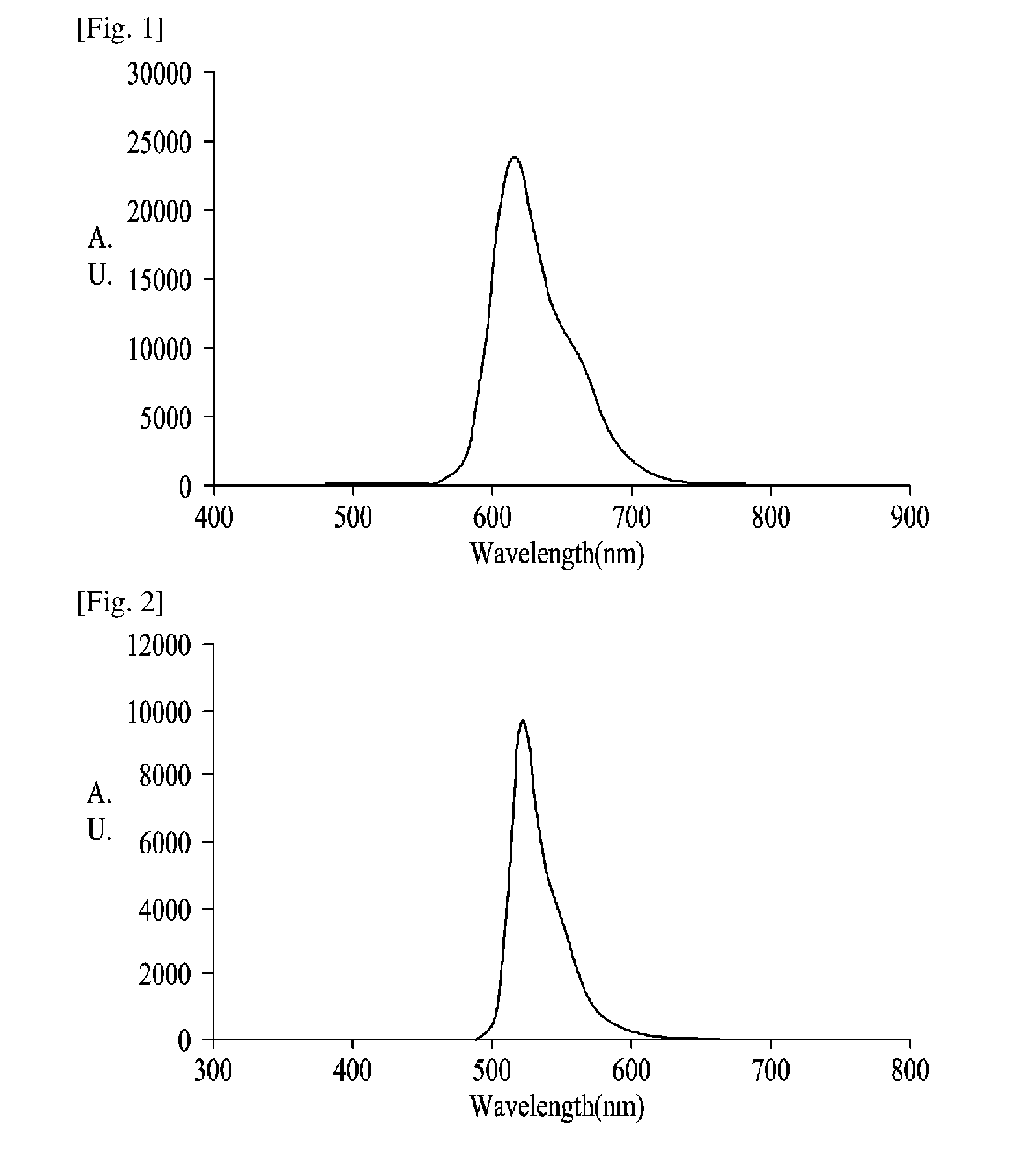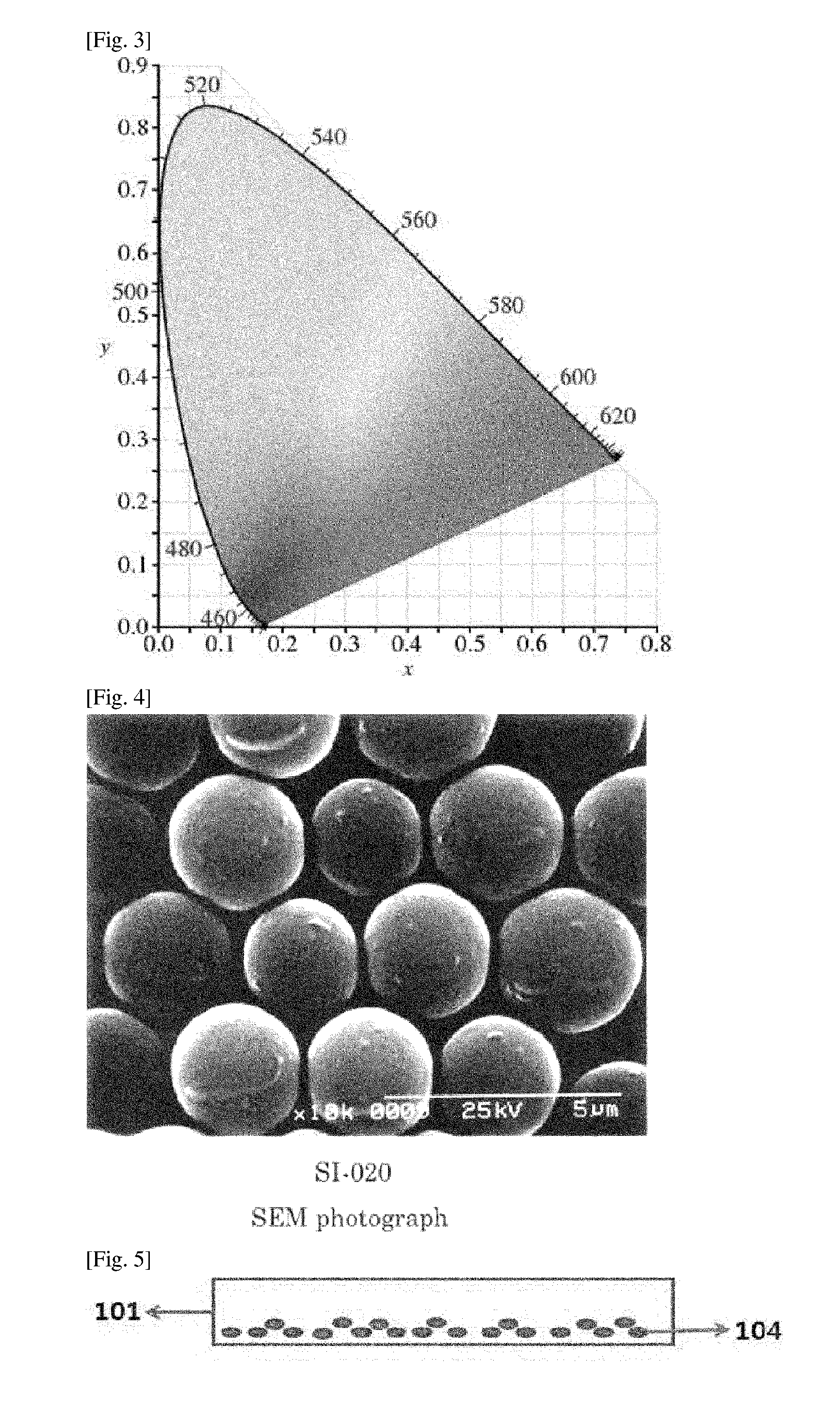Compensation Film and Organic Dot for Compensation Film
a compensation film and organic dot technology, applied in the field of compensation films, can solve the problems of inferior resolution, inferior securing of particle size or quantum yield (qy) to that of conventional cdse, and difficult mass production of indium sulfide quantum dots, so as to achieve the effect of increasing quantum efficiency and decreasing half width
- Summary
- Abstract
- Description
- Claims
- Application Information
AI Technical Summary
Benefits of technology
Problems solved by technology
Method used
Image
Examples
example 1
Preparation of Organic Dots Represented by Formula 1-1
[0075]To a three-necked flask, 1.0 g (1.199 mmol) of Formula a, and 828 mg (5.995 mmol) of K2CO3 were added, followed by evacuating. Nitrogen was injected, and n-methyl-2-pyrrolidone (NMP) was added thereto, followed by stirring.
[0076]Then, 564 mg (5.995 mmol) of phenol was added thereto, followed by heating to 80° C. and stirring at the temperature for 15 minutes to finish the reaction.
[0077]The reaction product was treated with water and an MgSO4 solution to capture water, and dried using a rotary evaporator. After that, the dried reaction product was separated using column chromatography to obtain a compound represented by the following Formula 1-1.
[0078]1H NMR (CDCl3, 400 MHz): 7.543 (t, 8H), 7.443 (t, 2H), 7.284 (m, 8H), 7.159 (t, 4H), 7.097 (d, 8H), 2.953 (m, 4H), 1.617 (d, 24H)
[0079]In Formula 1, R2 and R4 are
R7 and R8 are isopropyl, and R2, R3, R5 and R6 are phenoxy.
example 2
Preparation of Organic Dots Represented by Formula 1-2
[0080]To a three-necked flask, 1.0 g (0.927 mmol) of a compound represented by Formula 1-1 and prepared in Example 1, and 5 ml of H2SO4 were added, followed by stirring at room temperature for 15 hours to finish the reaction. Then, the reaction product was injected to water slowly, and solid was filtered.
[0081]Then, the solid thus filtered was washed with dichloromethane about three times, dried at 100° C. in vacuum to obtain a compound represented by Formula 1-2.
[0082]1H NMR (CD3OD, 400 MHz): 8.183 (s, 4H), 7.877 (d, 8H), 7.447 (t, 2H), 7.325 (d, 4H), 7.168 (d, 8H), 2.725 (m, 4H), 1.131 (d, 24H)
[0083][Formula 1-2]
[0084]In Formula 1, R1 and R4 are
R7 and R8 are isopropyl, R2, R3, R5 and R6 are
and R9 is —SO3H.
example 3
Preparation of Organic Dots Represented by Formula 1-3
[0085]To a three-necked flask, 1.0 g (1.199 mmol) of Formula a, and 828 mg (5.995 mmol) of K2CO3 were added, followed by evacuating. Nitrogen was injected, and n-methyl-2-pyrrolidone (NMP) was added thereto, followed by stirring.
[0086]Then, 996 mg (5.995 mmol) of methyl(4-hydroxyphenyl)acetate was added thereto, followed by heating to 60° C. and stirring at the temperature for 15 minutes to finish the reaction.
[0087]The reaction product was cooled to 25° C., and hydrochloric acid was injected thereto. Then, the pH of the reaction product was controlled to neutral using water, followed by washing and drying in vacuum. After that, the dried reaction product was separated using column chromatography to obtain a compound represented by the following Formula 1-3.
[0088]1H NMR(C2D2Cl4, 400 MHz): 8.147 (s, 4H), 7.882 (d, 8H), 7.342 (t, 2H), 7.189 (d, 4H), 7.097 (d, 8H), 3.802 (s, 8H), 2.497 (m, 4H), 1.061 (d, 24H)
[0089][Formula 1-3]
[0090...
PUM
| Property | Measurement | Unit |
|---|---|---|
| ) wavelength | aaaaa | aaaaa |
| thickness | aaaaa | aaaaa |
| PL) wavelength | aaaaa | aaaaa |
Abstract
Description
Claims
Application Information
 Login to View More
Login to View More - R&D
- Intellectual Property
- Life Sciences
- Materials
- Tech Scout
- Unparalleled Data Quality
- Higher Quality Content
- 60% Fewer Hallucinations
Browse by: Latest US Patents, China's latest patents, Technical Efficacy Thesaurus, Application Domain, Technology Topic, Popular Technical Reports.
© 2025 PatSnap. All rights reserved.Legal|Privacy policy|Modern Slavery Act Transparency Statement|Sitemap|About US| Contact US: help@patsnap.com



